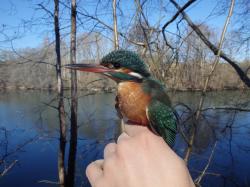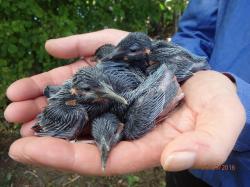Discussion
Winter severity

As reported from other studies in Europe (Poprach & Machar 2015), kingfisher populations fluctuate strongly over the years. While winters are mild in the southern parts of Europe and therefore might not affect the kingfisher population drastically (Banza et al.2015), it has been reported to play a major role in northern populations (Schmidt 2010). In southern Sweden, strong winters lowered strongly the amount of started nests in the following year, which suggests serious declines of the overall population. Also, nesting of the remaining breeding pairs started later the stronger the winter had been, while parents’ weights when starting their first clutch, their chicks weight, the breeding success and failure rate did not seem to differ.
Kingfishers are partial migrators (Arizaga et al.2010), meaning that parts of the population stay resident during winter, while parts migrate south (Haila et al.1986). Haila et al (1996) also suggests, that under condtitions where overwintering habitats are close, bigger parts of the population would only migrate if resources in the resident area become too sparse. According to the ringing data, overwintering areas of the Swedish population mainly expanded to nearby countries like Denmark, Netherlands and Germany, or even stay at the Swedish coast. Hence, more kingfisher residents might be present during mild and fewer up to none residents in strong winters, as migration could be adapted to the availability of ice free water bodies. Delayed breeding starts therfore might indicate a stronger migration and higher resident die offs in strong winters. Moreover, clutches are large with seven eggs and a high weight and good physical condition of the parents is necessary (Martin 1987). Therefore, surviving residents after strong winters also might have taken longer to recover and gain enough weight to effectively raise their chicks, as neither adult nor chick weight was affected by the strength of the winter. Overall, even though winter severity seemed to be an important factor influencing the overall kingfisher population in southern Sweden, it did not have a strong effect on the breeding success of the individuals.
Breeding success

The role of territorial behavior and colonization patterns of habitats have been discussed over many years. According to ideas by Fretwell & Lucas JR.(1970), population densities should depend on the quality of the habitat. Hence, higher quality habitat should have higher success rates and be colonized first. With more birds settling, the average success rate (suitability) for each bird steadily decreases, as resources have to be shared, and eventually habitats with lower quality become equally attractive. Those theories are supported by this study, as kingfishers spread out evenly in years with low populations and increased in density only around a few sites when populations became bigger. With even higher population increases, densities around those areas seemed to reach a limit of 5 to 8 neighbors and the number of birds around the less popular sites increased. As stress can lead to decreased clutch sizes (Martin 1987) and in this study higher number of neighbors loewered the breeding success, settling in an already occupied area might have been less beneficial to kingfishers, if other habitats of similar quality were entirely unoccupied. However, if competition was unavoidable due to bigger populations, site quality seem to be raise in importance, with the effect of the birds accumulating in the favored spots. With densities of 5 to 8 birds within 5 km, those sites seem to reach their carrying capacity. Hence, the common kingfisher might be able to judge the habitat according to environmental clues, rather than on the amount of competitors settled already.
This leads to the conclusion, that kingfishers choose their nesting sites according to habitat quality and occupation of an area. Avoiding competition in low density years hence seemed to be favored over breeding in the best habitat, while better sites would be the ones to be shared first when populations increased. High quality habitat therefore should be able to support more birds, however, quickly reaches the carrying capacities. Limiting factor of breedings did not seem to be the number of nesting sites, but rather habitat quality and the amount of birds nesting in the same area.
Habitat quality thereby did not seem to mainly depend on the breeding site. Even though significant effects were shown in other studies (Kafutshi & Komanda 2011, Heneberg 2004, Morgan & Glue 1977, Turcokova et al.2016, Schmidt 2010), the assessed parameters soil clay content, wall size, wall orientation and water distance did not have an influence on the breeding frequency in this study. This might be due to the few sites that have been assessed, or that many sites have been subject to human changes over the years. Moreover, other habitat factors that have not been assessed in this study have been stated to be important in literature, i.e. the number and availability of suitable fish in the river, river substrate, river side vegetation, visibility in the water and river depth (Vilches et al.2012). Those factors are not always connected to the breeding site directly, as fishing can be in any close by river, hence the surrounding habitat might have been of higher importance.
Responsible for this page:
Director of undergraduate studies Biology
Last updated:
05/11/17
